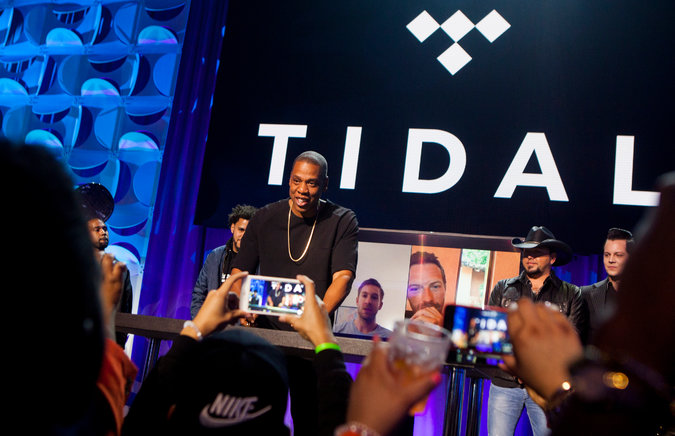
Last week Sprint announced a $200 million investment in the artist-owned streaming company, Tidal. The investment gives Sprint a 33% ownership stake in the service. Some have categorized the move as bold while others say it’s one of desperation as both companies have their work cut out for them in their respective fields—Sprint is behind Verizon and AT&T in revenue and subscribers just as Tidal lags Spotify, and Apple Music. The move is unprecedented and with many possible outcomes. So, what could come next? Here’s our take.
The Come Up:
There are some clear advantages and opportunities that both companies stand to gain. Tidal, the obvious beneficiary gains an influx of cash. Cash-flow is essential for young companies; it allows them to compete with bigger players and make bold investments needed for growth as opposed to struggling to survive to calm anxious investors. The deal also increases Tidal’s access to a new segment of users who may have otherwise not downloaded the service. This could potentially level out the playing field as they compete with Apple Music—which currently has the advantage of being automatically installed on every iPhone. This deal means that Sprint can seamlessly weave Tidal into their services. Tidal will also have a stronger platform to truly leverage the exclusivity that it touts as one of its main selling points. Finally, Tidal gets a new board member out of the deal, Sprint’s CEO, Marcelo Claure.

Sprint’s investment may seem steep, but they have some benefits in store as well. Sprint gets a significant stake in a music streaming platform, one of the main activities that people conduct on their smartphones. This gives Sprint an opportunity to enhance the benefits it offers to its customers. Discounted streaming subscriptions, early access to ticket sales, and exclusive offers to connect fans to artists are just a few of Tidal’s perks that Sprint could leverage for its customers. For customers who prioritize music over all else when using their phones, the deal may be makes Sprint attractive alternative to Verizon, AT&T, or T-Mobile. Finally, the deal also gives Sprint access to unique marketing opportunities. Sprint’s equity stake in an artist-owned streaming platform makes them a true partner to artists instead of a brand looking to borrow social capital. Sprint can leverage this to launch more dynamic marketing initiatives that extend beyond a cameo in a :30 TV spot.

The Side Eye:
Despite these advantages, there is a still a great deal of risk involved. For starters, it’s worth asking if Sprint overpaid for its stake. $200 million would put Tidal’s total value to somewhere in the ballpark of $600 million. Tidal’s subscriber numbers are not quite clear. Earlier this month a Norwegian newspaper revealed that they were inflating their numbers. The report revealed that Tidal only had about 1 million active users as opposed to the 3 million that Jay Z tweeted about in March of 2016. These numbers are a far cry from Spotify’s 40 million paying subscribers and Apple Music’s 20 million. Even Pandora, which has fallen behind in the streaming wars has more paying subscribers than Tidal has users.

Sprint will need Tidal’s performance to improve to make this deal worthwhile. Although this gives Tidal access to Sprint’s 45 million customers, getting them to abandon their Spotify playlists and/or Apple Music subscription to start anew with Tidal is no easy ask. Both companies would need more than exclusive content to make that sell. An option would to mitigate this could be discounted or free subscriptions. However, this would have Tidal sacrificing revenue in hopes of gaining volume, which wouldn’t have an immediate impact on its bottom line because it can’t capitalize off its audience by selling ads. It’s also worth noting that Android Phones and iPhones each come with their proprietary music service pre-installed. This means they will likely have to make some serious concessions or product improvements that bring true differentiation to lure users away from their current platforms.
The results of the deal have yet to unfold, but some things we can count on are Tidal and Roc Nation-affiliated artists and athletes featured in Sprint advertising. The collaboration will go beyond TV spots and take hold in the digital landscape. Tidal’s events will likely have exclusive perks for Sprint users on site and streaming of exclusive footage will be made available for Sprint’s customers. Tidal will see an increase in subscribers, but it is unlikely that this move alone will give it the boost it needs to catch up to Spotify and Apple Music. There is also the possibility of the unknown. There could be something visionary in play that we may not have the foresight yet. There’s also the wild card, culture. If the culture of the two companies is incompatible, their plans will be an exercise in futility. Regardless of the outcome, we can be certain that disruption will continue to sweep through the music industry. It’ll be interesting to see how this move plays out.

Let us know your thoughts in the comments below.
